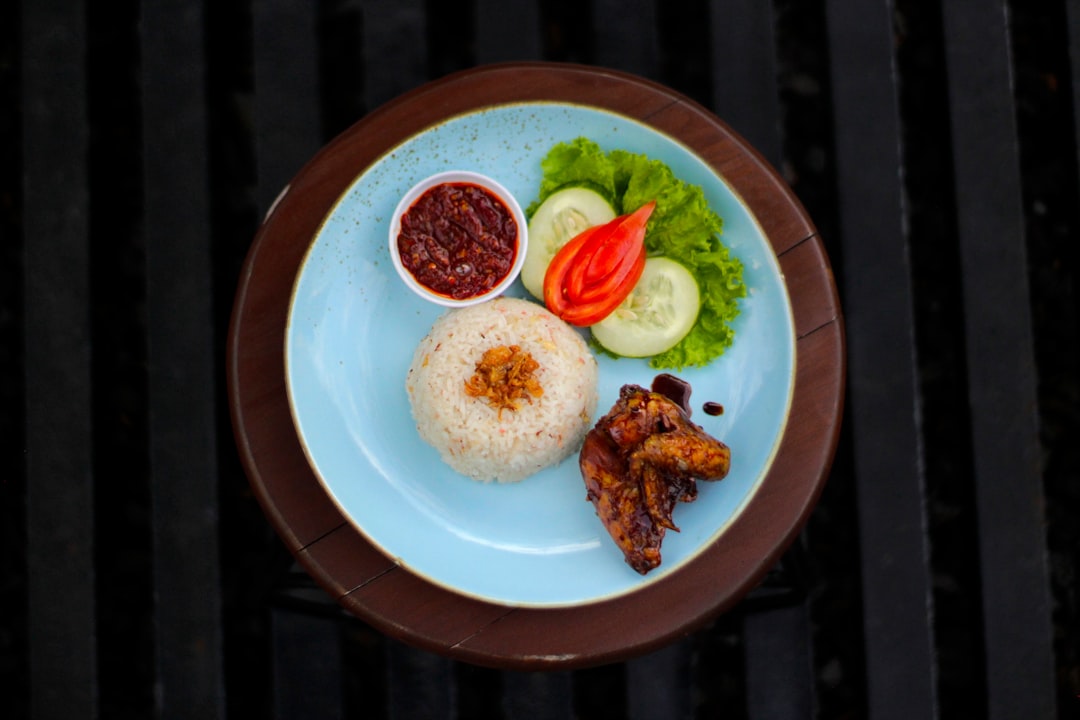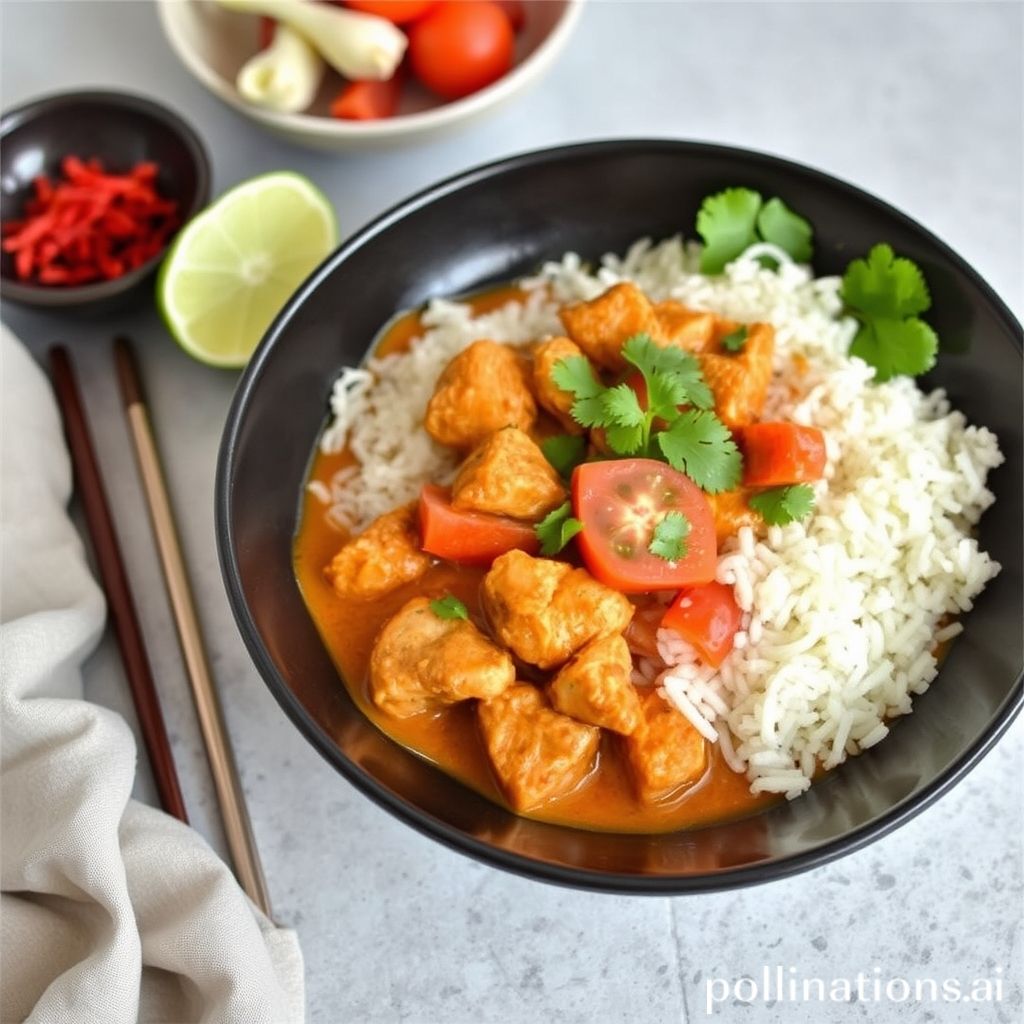Table of Contents
- Introduction
- The origins of Thai red curry chicken
- Essential ingredients for Thai red curry chicken
- Step-by-step preparation of Thai red curry chicken
- Common variations and substitutes in Thai red curry recipes
- Nutritional benefits and health considerations of Thai red curry chicken
- Conclusion
- Frequently Asked Questions
Introduction
Thai Red Curry Chicken is a tantalizingly aromatic dish that showcases the perfect harmony of sweet, savory, and spicy flavors. To embark on this culinary adventure, gather these essential ingredients:
- 2 tbsp of vegetable oil
- 1 lb of chicken breast, sliced
- 1 can (13.5 oz) of coconut milk
- 2 tbsp of Thai red curry paste
- 1 tbsp of fish sauce
- 1 tbsp of brown sugar
- 1/2 cup of bell peppers, julienned
- 1/2 cup of bamboo shoots
- 1 lime, juiced
- Fresh basil leaves, for garnish
- Steamed jasmine rice, to serve
Can you already smell the fragrant spices wafting through your kitchen? Thai Red Curry Chicken is not just a dish; it is an experience that tantalizes the senses.
With each ingredient playing an instrumental role in achieving the authentic richness that this Southeast Asian staple is renowned for, you’re about to delve into a symphony of flavors that will transport you straight to the bustling streets of Thailand.
The origins of Thai red curry chicken
Thai Red Curry Chicken is a beloved dish that originates from Thailand, a country known for its rich and diverse culinary traditions. The origins of this flavorful dish can be traced back to the central plains of Thailand, where the subtle blend of spices and herbs are central to local cuisine. Historically, Thai curry was influenced by Indian curries introduced to Thailand through cultural exchanges and trade routes. Over time, the Thai people adapted these influences to their tastes, incorporating local ingredients to create the distinct flavors we associate with Thai curries today.
Red curry, or “kaeng phet,” is characterized by its vibrant color, which comes from the dried red chilies used in the curry paste. The paste is a harmonious blend of lemongrass, garlic, galangal, and shrimp paste, among other ingredients. Coconut milk adds a creamy base that helps to balance the heat from the chilies and enhance the aromatic flavors. Traditionally, the dish was prepared with locally-sourced protein, and chicken emerged as a popular choice due to its availability and richness, complementing the curry’s taste perfectly. Over the years, Thai Red Curry Chicken has gained worldwide popularity, becoming a staple in Thai restaurants globally.
Essential ingredients for Thai red curry chicken
Thai Red Curry Chicken is a flavorful and aromatic dish that owes its deliciousness to a handful of essential ingredients, each contributing uniquely to its rich tapestry of flavors. At the heart of this dish is the red curry paste, a vibrant blend made from red chili peppers, garlic, lemongrass, galangal, and other fragrant herbs and spices. This paste provides the signature heat and depth of flavor that distinguishes Thai red curry from other curries.
Coconut milk is another indispensable component, lending a creamy texture and a hint of sweetness that balances the spice from the curry paste. Fresh chicken, typically cut into bite-sized pieces, absorbs these flavors beautifully.
Additional ingredients include fish sauce, which adds a savory umami richness, and sugar, which harmonizes the flavors with a touch of sweetness. Kaffir lime leaves impart a citrusy aroma, while fresh vegetables such as bell peppers, bamboo shoots, or Thai eggplants introduce textures and colors to the dish.
Basil and cilantro are often used as garnishes, adding a burst of fresh flavor to each serving. Together, these ingredients not only define the taste of Thai Red Curry Chicken but also reflect the harmony of flavors characteristic of Thai cuisine.
Step-by-step preparation of Thai red curry chicken
Preparing Thai Red Curry Chicken is a delightful culinary journey that can be completed with ease by following a few steps. Begin by gathering your ingredients: boneless chicken pieces, Thai red curry paste, coconut milk, vegetables like bell peppers, bamboo shoots, and fresh Thai basil leaves. Make sure to have fish sauce and sugar on hand for seasoning.
Start by heating a tablespoon of oil in a skillet over medium heat. Add two tablespoons of red curry paste to the oil, stirring constantly for about two minutes until the paste begins to release its enticing aroma. Next, gradually pour in a can of coconut milk, stirring to mix thoroughly with the curry paste.
Add the chicken pieces into the skillet and allow them to cook, stirring occasionally until they’re no longer pink. Mix in your vegetables, layering the flavors and adding vibrant colors to the dish. Let everything simmer together for about 5-7 minutes until the vegetables are tender-crisp.
Finally, season the curry with fish sauce and a pinch of sugar, adjusting to taste. Garnish with fresh Thai basil leaves before serving. This dish pairs beautifully with steamed jasmine rice, allowing you to savor the rich, creamy, and spicy notes that Thai cuisine is celebrated for.
Common variations and substitutes in Thai red curry recipes
Thai Red Curry Chicken is a versatile dish that can be customized to suit various tastes and dietary needs. Common variations include using different proteins such as shrimp, beef, or tofu to replace chicken, making it a flexible option for both meat-lovers and vegetarians. The vibrant red curry paste is a key ingredient, but for those who prefer a milder flavor, you can opt for a yellow or green curry paste to adjust the spice level. Coconut milk is typically used to bring a rich, creamy texture to the dish; however, light coconut milk or even almond milk can be used as substitutes for a lower-fat version.
Vegetables are another area where creativity shines. Traditional choices like bell peppers, bamboo shoots, and eggplant can be swapped with whatever is seasonally available or preferred, such as zucchini or snap peas. For added depth of flavor, some people like to add kaffir lime leaves or Thai basil, though these can be substituted with other herbs like cilantro if necessary.
Lastly, the dish is usually served with jasmine rice, but for a healthier alternative, you can use brown rice or quinoa. These variations and substitutes make Thai Red Curry Chicken an adaptable meal that can easily cater to diverse palates.
Nutritional benefits and health considerations of Thai red curry chicken
Thai Red Curry Chicken is not only a flavorful dish but also offers several nutritional benefits. Made primarily with chicken, coconut milk, red curry paste, and a variety of vegetables, this dish provides a good balance of protein, healthy fats, and essential nutrients. Chicken is a lean source of protein, which is crucial for muscle repair and growth. The use of coconut milk adds healthy saturated fats, which have been linked to improved heart health and better immunity.
In addition to these macronutrients, Thai Red Curry Chicken contains beneficial vitamins and minerals. The incorporation of vegetables like bell peppers, bamboo shoots, and basil contributes important vitamins such as vitamin C and vitamin A, promoting a healthy immune system and good vision. These vegetables can also provide dietary fiber, which is essential for digestive health.
However, it is important to consider the health aspects of the dish in terms of calorie and sodium content. Coconut milk can be high in calories, and red curry paste often contains a significant amount of salt. For those monitoring their sodium intake or calorie consumption, it is advisable to use light coconut milk and control the portion size.
Conclusion
Mastering the art of Thai Red Curry Chicken is more than just a culinary journey; it’s an invitation to experience the vibrant tapestry of Thai cuisine right at home. With its rich blend of spices, creamy coconut milk, and fresh ingredients, the dish offers a perfect balance of flavors and textures. Whether you prefer the traditional recipe or enjoy experimenting with variations and substitutes, Thai Red Curry Chicken delivers satisfaction to any palate.
Beyond simply being delicious, this dish also provides nutritional benefits, making it a wholesome choice for health-conscious individuals and families alike. From its origins to modern adaptations, Thai Red Curry Chicken showcases the versatility and charm of Thai cooking. To enhance your culinary repertoire even further, consider exploring more chicken recipes with The Chicken Bible: Say Goodbye to Boring Chicken with 500 Recipes for Easy Dinners, Braises, Wings, Stir-Fries, and So Much More. This ultimate guide is your ticket to endless flavorful meals that will impress and delight each time you cook.

